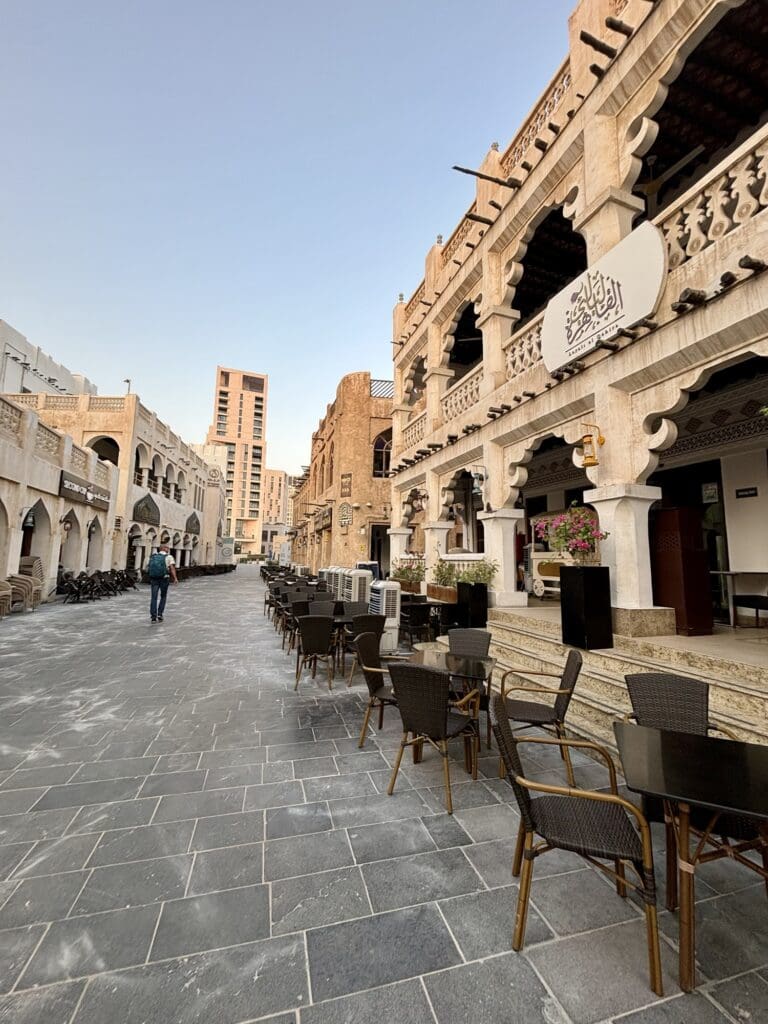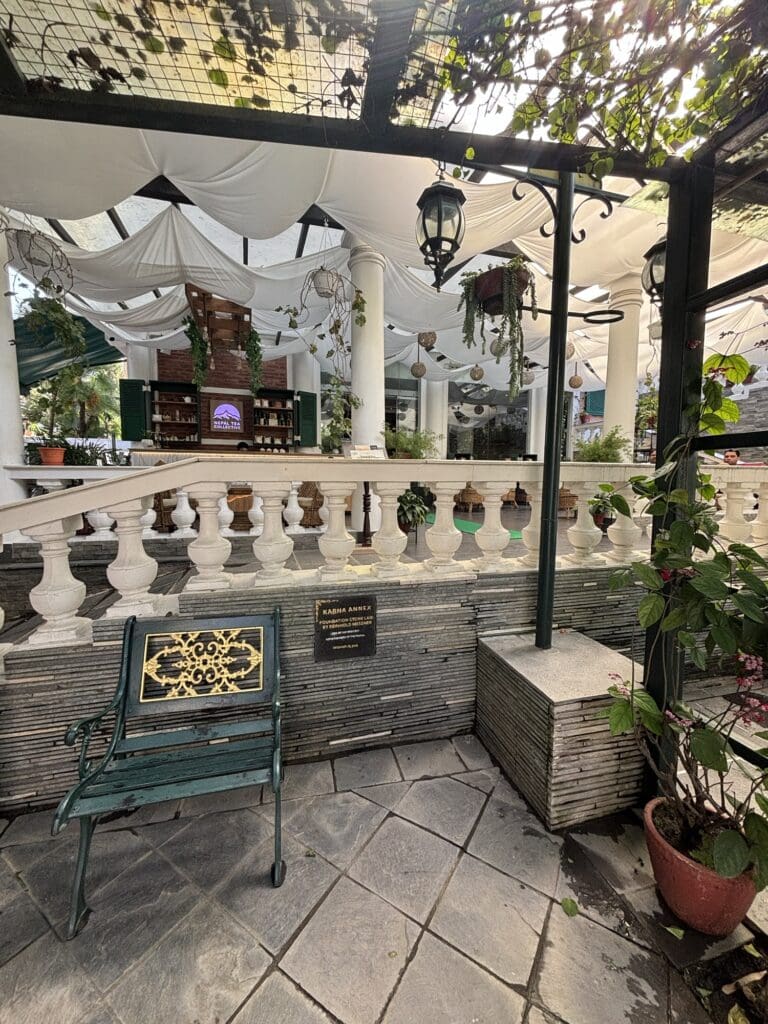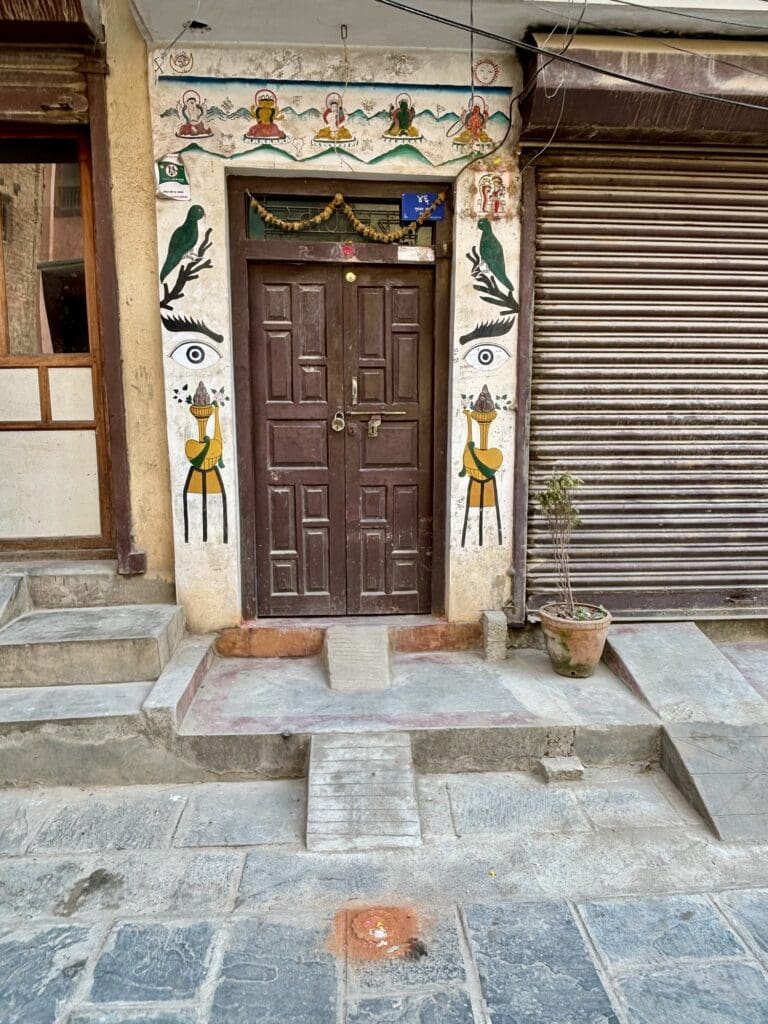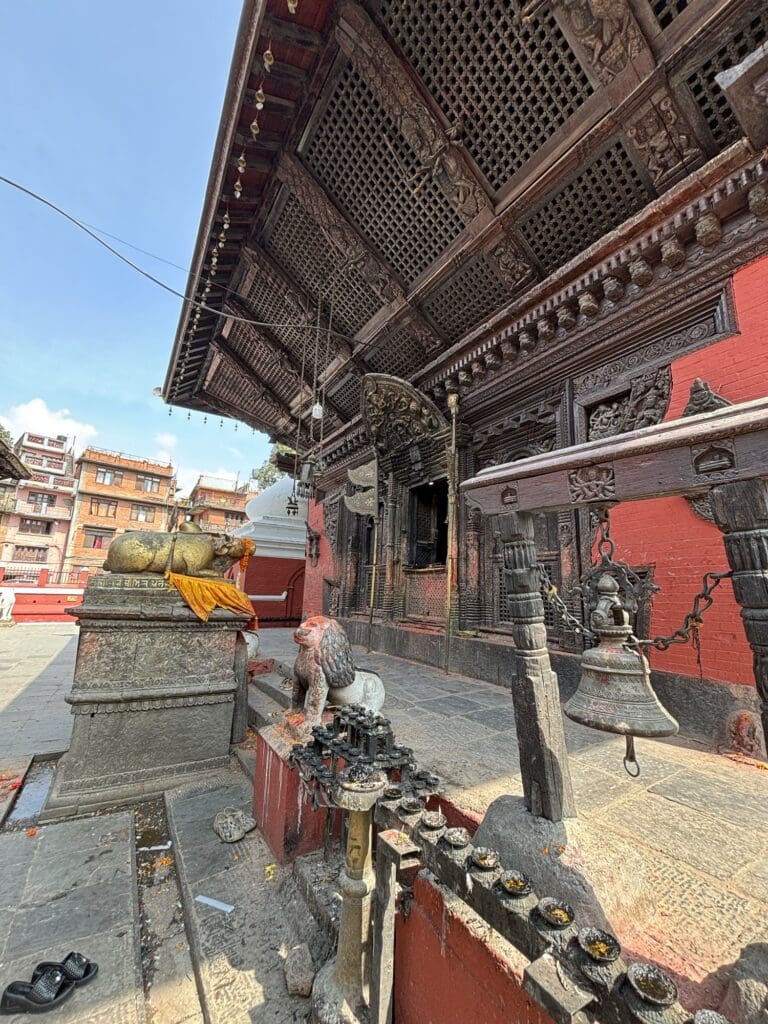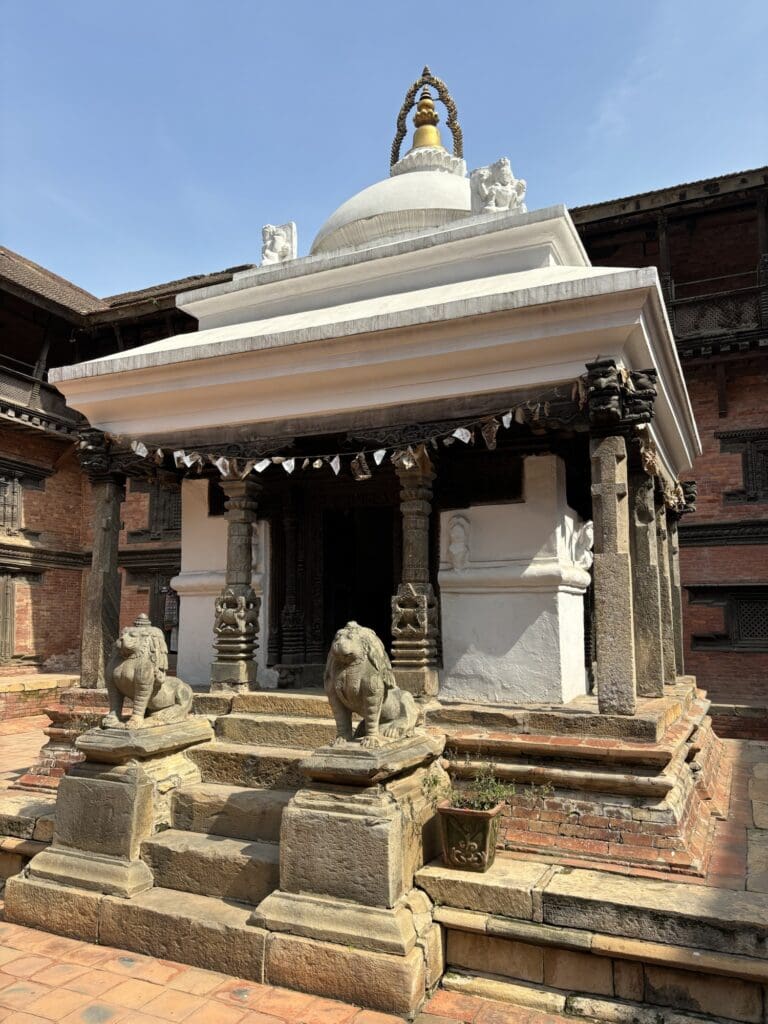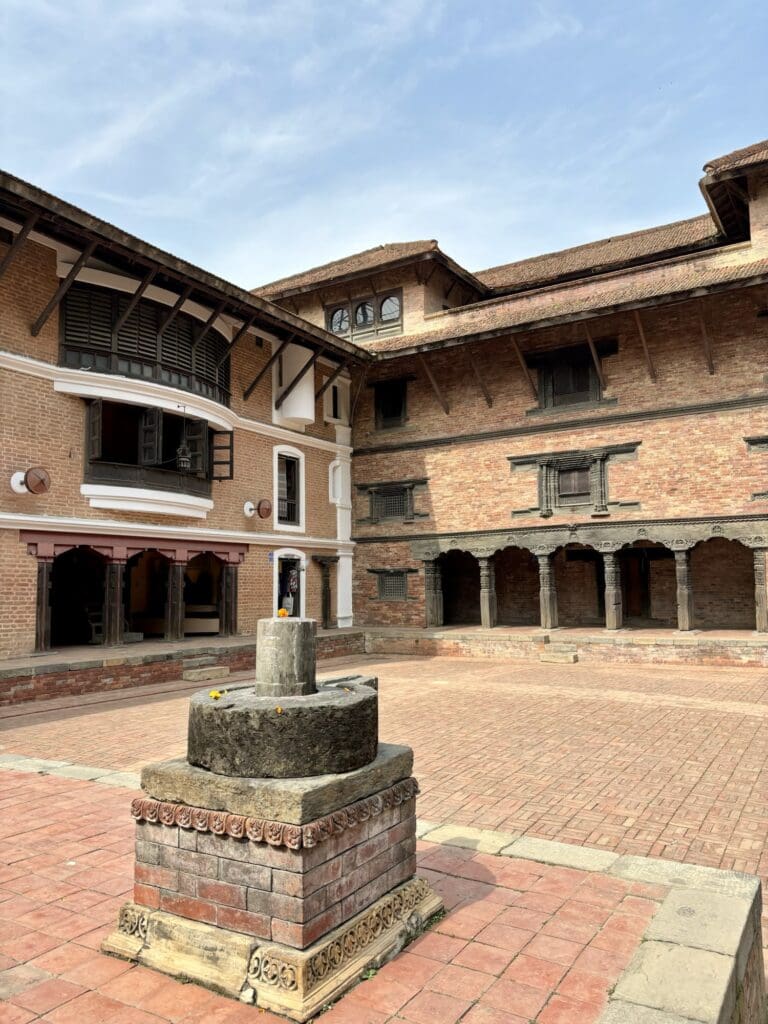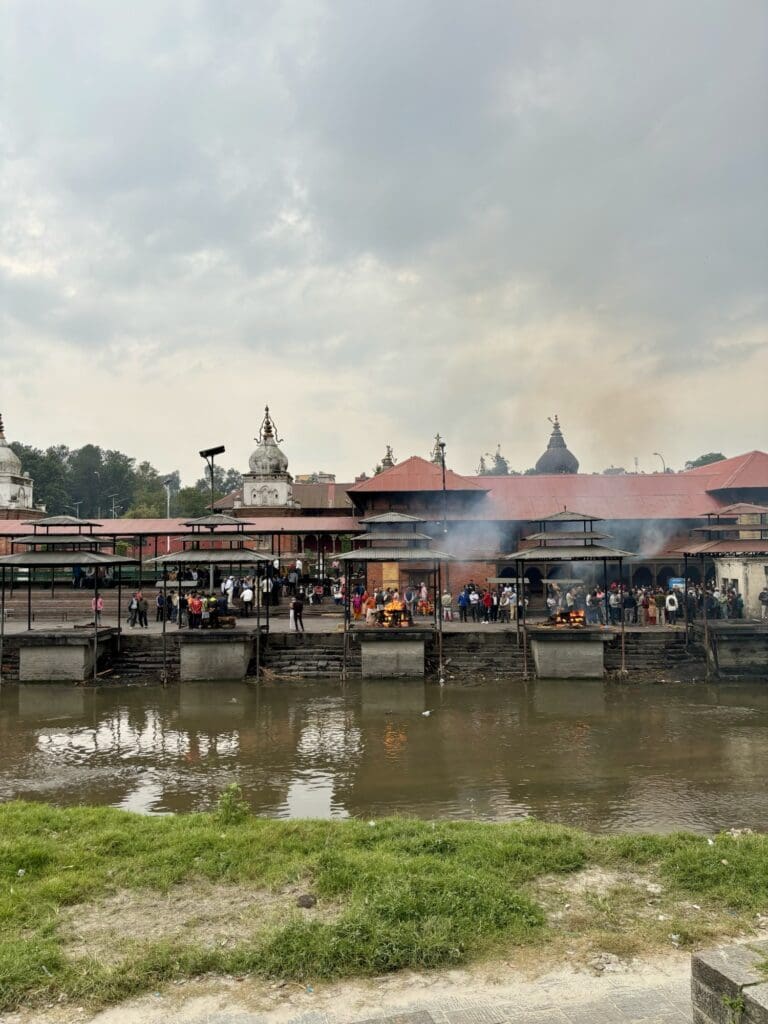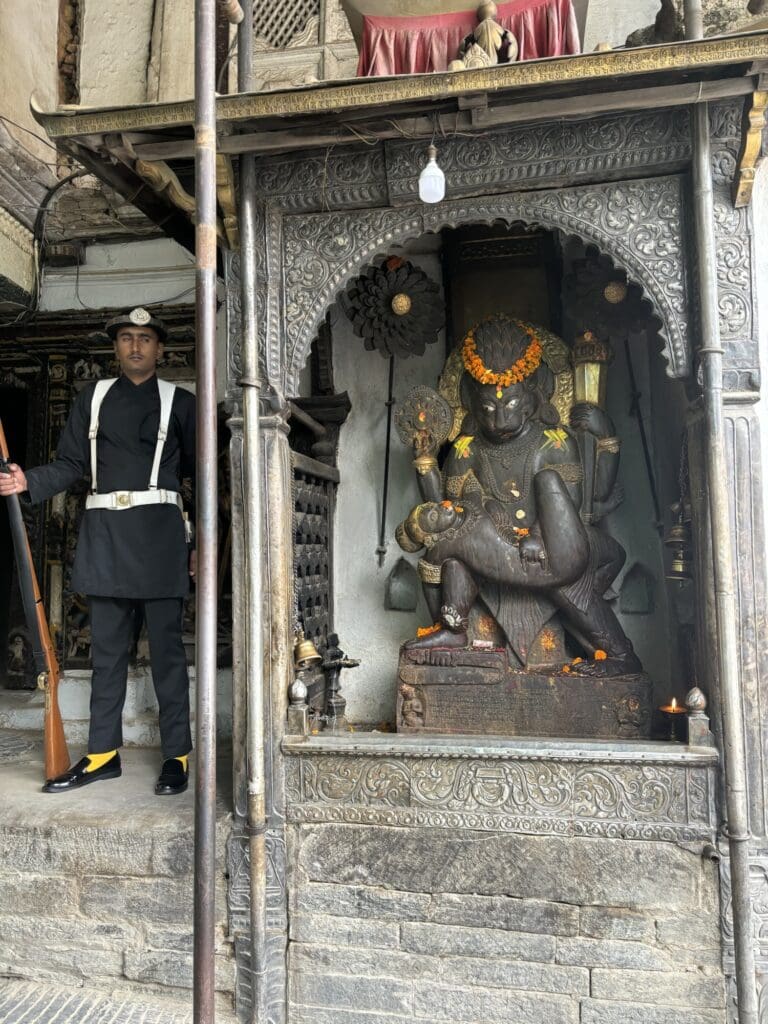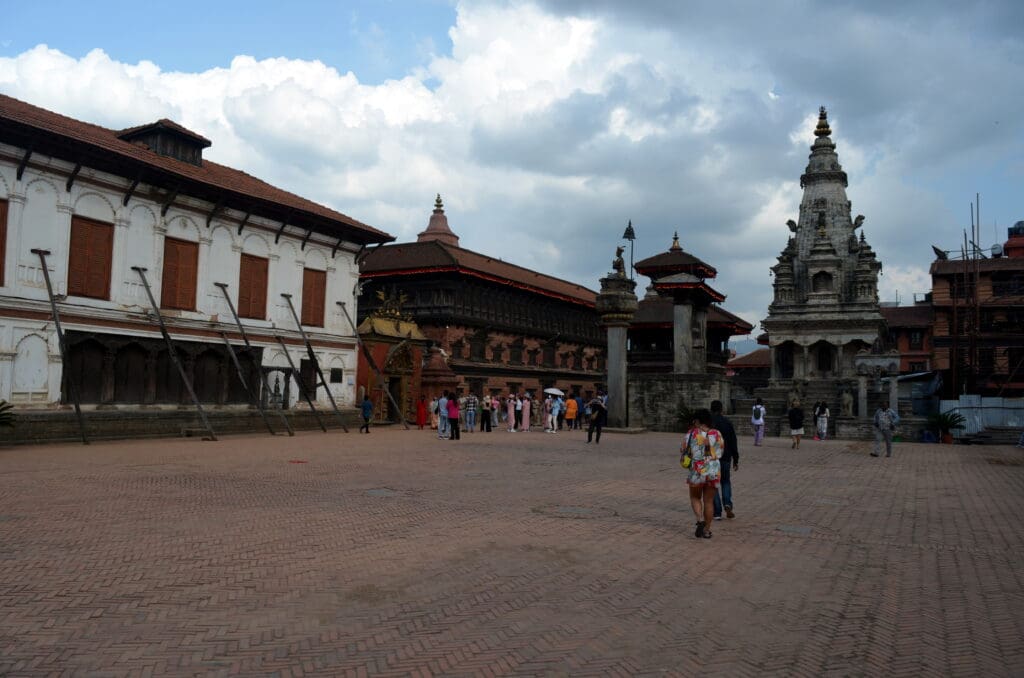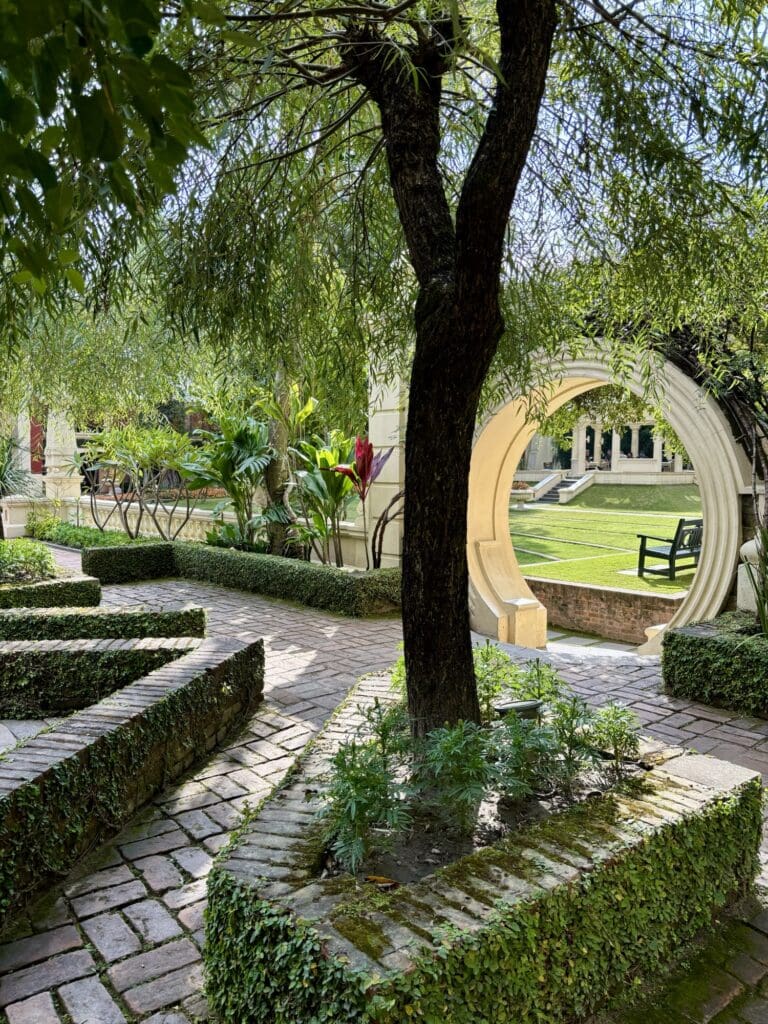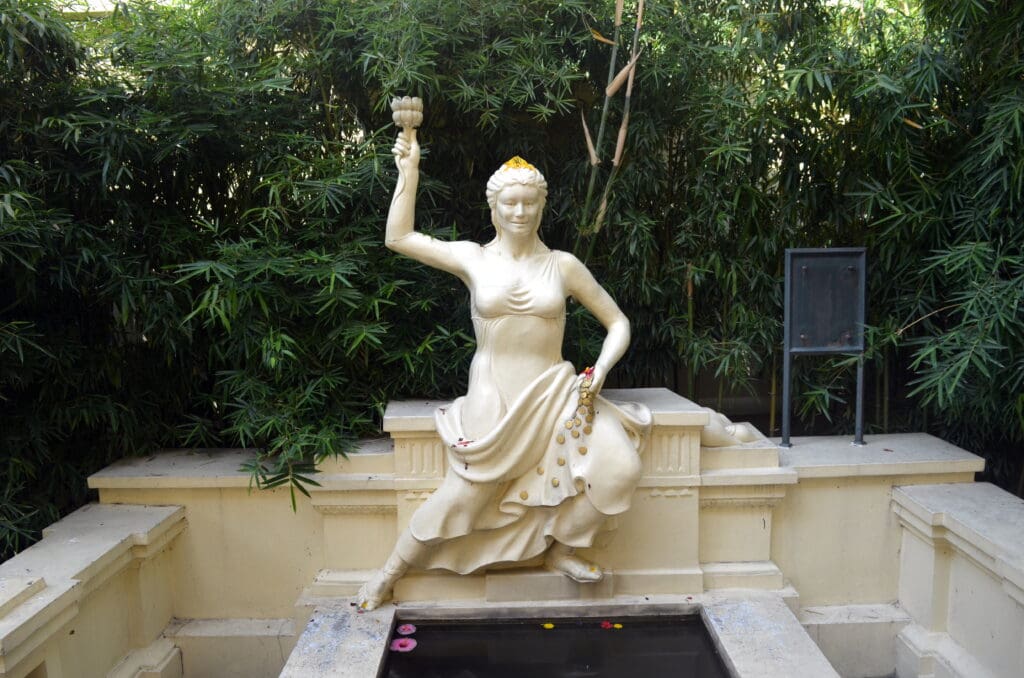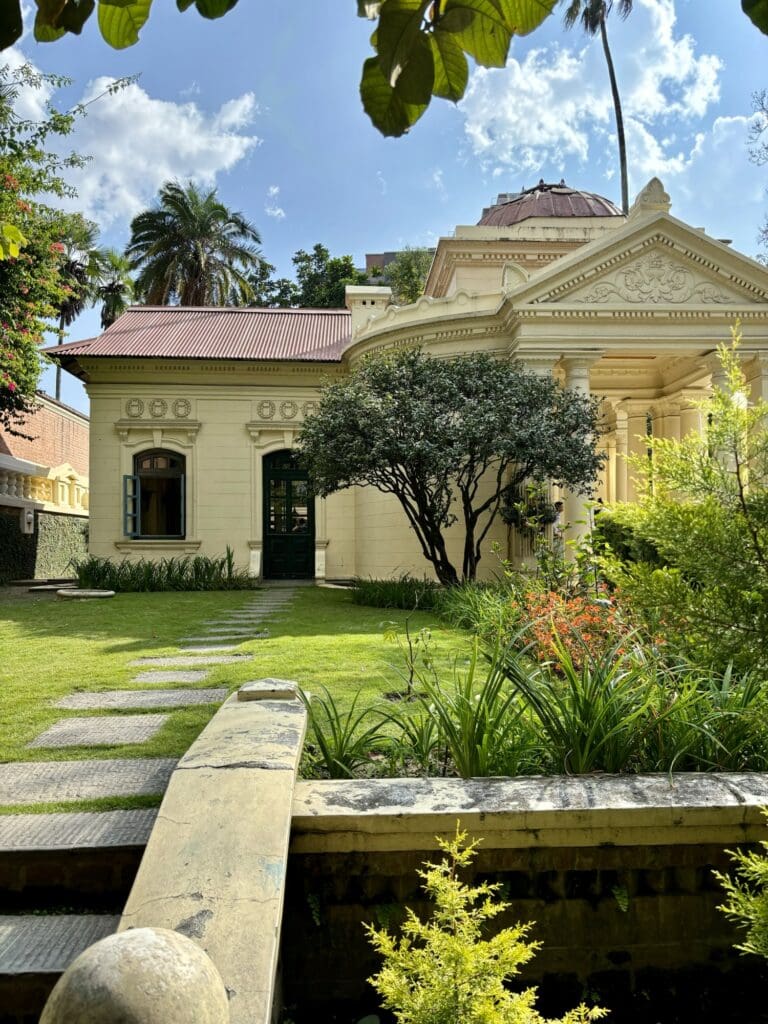Our big adventures are often in remote places, which means they usually start with multiple flights and long plane rides. This trip was no exception. We drove from Austin to Houston on Thursday, and Kurt worked remotely from the hotel there on Friday before we headed to the airport in the afternoon. Our 14+ hour flight from IAH to DOH was delayed by two hours, so it made a long travel day/night even longer. Thankfully, we didn’t have a flight connection that we were in danger of missing, so no Friday the 13th scaries! We arrived in Doha, Qatar in the early evening on Saturday, and we were greeted with very hot conditions even after the sun had gone down (low 90s at night, 110+ during day).
This was our first trip to the Middle East, and we had an immediate awareness of the Islamic culture difference with men and women wearing the traditional dress of Qatar, the thobe for men and the abaya for women, and separate areas for men and women in public spaces. I tried to ensure that I was dressed more modestly myself once we left the airport (no bare shoulders or legs).
Thankfully, we easily navigated our way on the metro from the airport to the area around the touristy (but only old and historic in appearance) Souq Waqif. Due to our long layover, we had booked a discounted hotel room for the night via the Discover Qatar stopover program, which allowed us to take a shower and get a few hours of decent sleep in a real bed rather than staying in the airport (even though Hamad International Airport has to be one of the largest and fanciest airports that we’ve traveled through). Once on foot, we had some difficulty locating our hotel, but thankfully the Souq Waqif Boutique Hotel is a hotel group with multiple properties so they readily accommodated us at the facility that we popped into looking for directions. The hotel was located next to a falcon hospital, souk, camel pen, horse stable, and Persian Gulf – not your ordinary hotel by any means. After a quick tour of the surrounding area, we showered and went to bed in order to maximize our amount of sleep for the night.
We checked out early and took the metro back to the airport for our morning flight to Kathmandu, Nepal. The flight duration was about 4.5 hours with a time change of two hours, forty-five minutes ahead upon arrival. All of this factored into helping us adjust to the time difference between the U.S. and Nepal. We easily navigated the visa and immigration area, thanks to last minute intel from a friend who had arrived earlier in the month. Pro tip: upon arrival in KTM, have a printout of your online visa ready then go pay (cash only, USD accepted) for the visa at the counter on the left before proceeding to the immigration line. We were then met outside of the airport by our hotel rep for transport to the hotel (hotel shuttle pick-up signs are located outside under the awning after exiting the airport). The ride offered our first glimpse into the chaos that is Kathmandu. Kurt immediately observed that there were no street signs or building numbers, which would make our ability to navigate around the city on foot difficult.



Our home for the week was KTM Guest House, an institution renowned for hosting writers, adventurers, dignitaries, and celebrities, in Thamel (the area of Kathmandu most frequented by tourists). Indeed, each of the rooms in the newly renovated hotel suites are dedicated to famous Nepalis; our room was for author, Samrat Upadhyay. The hotel is configured around a large central courtyard, which provides a welcome respite from the noise and traffic just outside of the hotel gates. We soon dubbed the hotel “the compound,” precisely for the safety and comfort that it provided away from the overstimulation of the city streets.
October is the peak month for trekking in the Himalaya. When we arrived, the hotel lobby was filled with The North Face duffel bags (some authentic, some not, as we later learned that the streets of KTM are brimming with shops selling knock-off gear for expeditions) of those who were off adventuring, awaiting them upon their return. We observed several groups meeting with their trip leader(s) throughout the week to discuss the details of their upcoming expeditions. Similarly, the local rafting partner (Shree from Ultimate Rivers) for our trip greeted us at the hotel when we arrived.
We learned that “festival” had started, which meant that many people were leaving the city to go home to their villages to visit family and those abroad were also returning home. Dashain is one of the major Hindu festivals celebrated all around the world (also known as Navaratri, Dusshera and Vijaya Dashami). The festival celebrates the victory of good over evil where goddess Durga, one of the Astamatrika kills the demon Mahishasura after a ten-day long battle. The nine days of the fight is symbolized as the Navaratri (translating to nine days). For Nepalis, the tenth day, or Dashami is the most important day of Dashain when people visit relatives and elderly families to receive tika, the combination of red powder, yogurt, and rice that is applied to their foreheads as a blessing.
After settling into our room, we had dinner in the hotel courtyard (and, ate our first of many momos, steamed dumplings, of this trip). Then, much to Kurt’s surprise and exasperation, I booked a full day tour around the Kathmandu Valley for the next day through the hotel’s travel desk. Nothing like easing into things! I knew that a tour would force us to stay awake all day tomorrow, while we would succumb to jet lag and sleep the day away if left to our own devices. Besides, with multiple UNESCO World Heritage sites in the area, there’s no shortage of places to visit this week.
- Hanumandhoka Durbar, Kathmandu
- Swayambhunath Stupa, Kathmandu
- Pashupatinath Temple, Kathmandu
- Boudha Stupa, Kathmandu
- Changunarayan Temple, Bhaktapur
- Bhaktapur Durbar, Bhaktapur
- Patan Durbar, Lalitpur
- Mayadevi Temple, Lumbini
On Monday morning, we met with Shree again after breakfast to finalize our itinerary for our add-on days before and after our whitewater rafting trip with BioBio Expeditions. Unfortunately, it looked unlikely that we would be able to do an Everest Heli tour that week because the government (temporarily) shut down tours due to a recent helicopter accident. We were pretty disappointed, but also definitely understood the safety concerns.
Our local driver and tour guide for the day met us at the hotel around 10am, as we had a full day ahead. I was eager to get out and explore this unique city that I had only heard of in the context of mountaineers bound for Everest. Never in my wildest dreams did I imagine that I would be here myself one day.
The city turned out to be sensory overload with its maze of unmarked streets filled with noisy cars, motorbikes and people at every turn, and a jumble of no-way-that’s-safe powerlines overhead. This is definitely a place where it helps to have a local driver and guide as you explore.
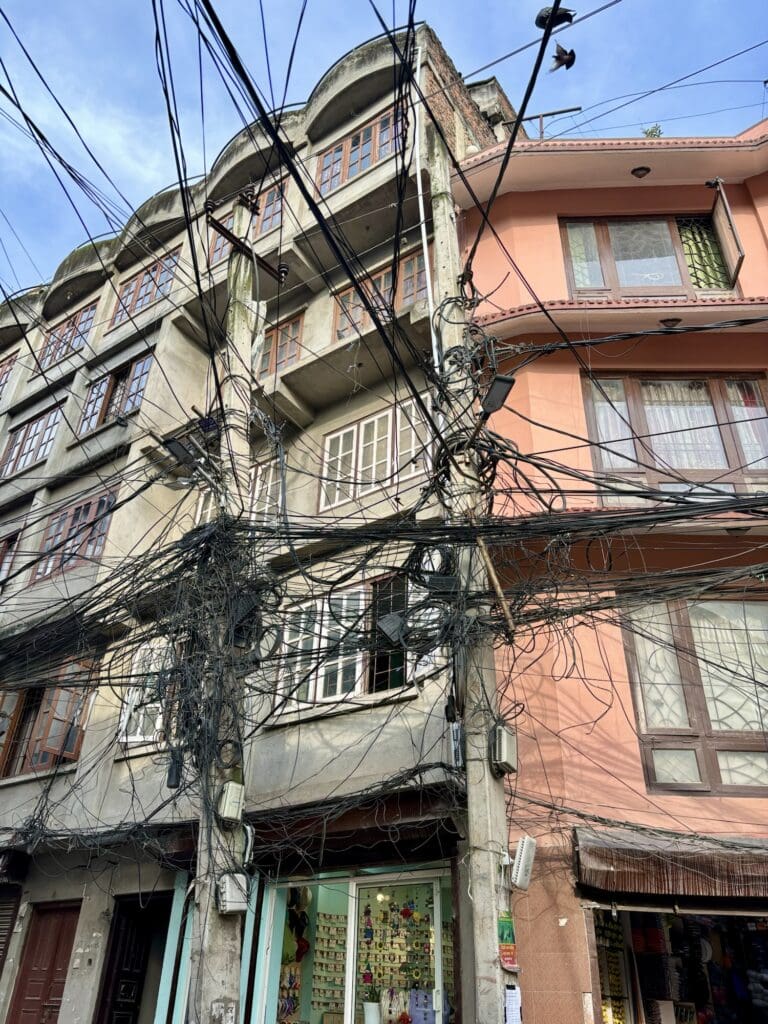
Our first stop of the day was to visit Swayambhunath Stupa located on a hill in the northwest part of Kathmandu Valley, giving visitors a panoramic view of the city (NPR 250). Visitors for whom the name was a tongue twister have called it “Monkey Temple” from the 1970s…because, you guessed it, there’s plenty of rhesus macaques roaming the area. Even though our guidebook suggested that “walking is the most enjoyable way to reach Swayambhunath,” (even giving our hotel as the starting point for the walk) I can confidently say that there is absolutely no way that we could have navigated ourselves there alone (particularly given that this was our first foray out in a still jet-lagged state). Our driver dropped us off near the stupa so that we didn’t have to climb the steep stone steps of the eastern stairway (we descended that way though).
The structure of the stupa is significant. A stupa incorporates five basic geometric shapes that correspond to the five elements (earth, water, fire, air, space). A thirteen-tiered tower made of gold panels lies above the large dome and represents the thirteen stages required to reach nirvana. Brightly colored prayer flags covered in sacred phrases fly over the stupa, so that the messages can be carried to heaven. Meanwhile, Tibetan Buddhists circulate around the base of the dome spinning metal prayer wheels (always) clockwise. The Buddhist mantra “om mani padme hum,” which means “hail to the jewel in the lotus,” is painted or embossed on the outside of the wheel and written on a roll of paper or cloth placed inside the wheel. Every spin of the prayer wheel is believed to be spiritually equivalent to orally reciting the mantra.
From there, we headed south across the Bagmati River to visit Patan Durbar Square, which is situated at the center of the city of Patan (also called by its original Sanskrit name of Lalitpur – City of Beauty). It is one of the three Durbar Squares in the Kathmandu Valley, all of which are UNESCO World Heritage Sites (tourists are required to pay an admission fee – NPR 1,000). A central attraction of Patan Durbar Square is the ancient royal palace where the Malla Kings of Lalitpur resided in the 16th-18th centuries. With our guide, we wandered the mass of temples, palace courtyards, and monuments in the area, taking in our first introduction to Newari architecture. Kurt remarked that the temples looked like the style common in Tibet and other Himalayan outposts, and our guide replied that the Newari actually created the style and exported it throughout the region. We could not see everything in the detail that we would have liked in the short time allocated on our day tour, so most of a day would probably be needed to fully take in the area.
Our next visit was to Boudhanath, also called the Khäsa Chaitya, located about 11 km (6.8 mi) from the city center in the northeastern outskirts of Kathmandu. The Buddhist stupa of Boudha Stupa dominates the skyline, and the stupa’s massive mandala makes it one of the largest spherical stupas in Nepal (NPR 400). The stupa is surrounded by restaurants and shops featuring the work of local artisans. We stopped for a late lunch at a rooftop restaurant with a great view of the square.

Our final stop for the day was to the Pashupatinath Temple, a famous and sacred Hindu temple complex that is located on the banks of the Bagmati River, approximately 5 km northeast of Kathmandu in the eastern part of Kathmandu Valley (NPR 1000). Only Hindus are allowed to enter the temple itself though. So, our guide led us across the river for views of the backside of the temple. There, we were also able to view the ancient stone cremation ghats that line the holy river. Pashupatinath is one of the city’s most important funeral sites. And, during our visit, we witnessed attendants preparing for upcoming cremations by assembling bamboo stretchers and stacking wood for funeral fires. We even observed a ceremony occurring from a respectful distance across the river. It was interesting to see such a public display of mortality with smoke and ashes of loved ones mingling in the air and water.
After a very full first day exploring yesterday, we needed a more relaxed day on Tuesday. So, we started off the day with a massage at the hotel after breakfast (90 min for $23). You can’t beat that! Then, we decided to venture out of the compound on our own, and we successfully walked to Durbar Square (remember, there are three different Durbar Squares in the area – we visited a different one yesterday). This one is essentially the medieval heart of Kathmandu where the royal palace is located (Hanuman Dhoka; a separate entry fee is required to enter the palace courtyards and Tribhuvan Museum), but it has since been enveloped by the urban sprawl of the city. Unlike yesterday when our guide directed us to the entrance gates of the sites that we visited, we were yelled at to come over and pay immediately as we approached the square (unlike the locals who simply walk through on the way to their destinations). Before we left later that afternoon, we decided to take our entry ticket for the day along with our passports and a passport photo to the site office in order to get a free Durbar Square entry pass good for as long as our Nepal visa is valid – just in case we came back with our group later in the week.
Damage to the palaces and temples here from the 2015 earthquake was still visible, and locals remain in the process of restoring the square to its full glory. Immediately upon entering, we were swarmed by tour guides hawking their services to us. We preferred to explore on our own at our own pace though. One of the men encouraged us to head to the Kumari Ghar first in order to catch one of the last appearances of the Kumari, Nepal’s living child goddess, for the day (the outer doors are closed later in the day, so it’s important to visit the courtyard in the morning). A truly bizarre scene then unfolded, as we waited with many others in a small courtyard for the young girl to come to the balcony above. No pictures are allowed of the Kumari, so staff closely monitored visitors and then gave the all-clear for her to step out. She appeared briefly, looking disinterested in the whole process, and then just as quickly retreated behind the closed window. It was such a weird experience that we stayed to witness it a second time! We also took in the ornate woodcarving on the doorways, windows, and balconies in the courtyard. The chariot for the Kumari is found outside of the building.
We took a break from the bustle of the square, exiting south to the famous Freak Street (aka Jhochhen) in search of a quiet restaurant for lunch. Historically, Freak St. was the center of Kathmandu for the many hippy travelers who visited the area for trekking. Now, more of that action has shifted to Thamel, and Freak St. is quieter, lined with hipster cafes and souvenir shops.
While the sprawling Hanuman Dhoka complex dominates the square, various other temples and shrines can be found as well. Some of our favorites included the Kala (Black) Bhairab (fearsome incarnation of the Hindu god Shiva), mask of Seto (White) Bhairab, and Ashok Binayak Temple (trekkers come to make an offering to Ganesh to ensure safety on their upcoming journey). The Gaddhi Baithak (“throne hall”) stands out distinct from the Newari architecture of all the other buildings, as it was constructed in the neo-classical European style in 1908 as the place where the King received foreign delegates.
After we finished our sightseeing at the square, we stopped at one of the many pharmacies that lined the streets on our way back to the hotel. I could feel the rumblings of a sinus infection developing, and I knew that I didn’t have time to be sick once we hit the river during the upcoming week. I simply advised of my symptoms (sinus pressure), and then I was given an antibiotic, nasal decongestant, and throat lozenges at a very low cost. Boom, easy enough.

Feeling slightly more comfortable with our orientation, we ventured outside of the compound again for dinner at Kathmandu Grill that evening.
On Wednesday, we (okay, I) opted for another guided tour to explore other areas around the Kathmandu Valley. We departed the hotel at 8am with a different guide than we had on Monday, and we drove to Nagarkot, a village in central Nepal at the rim of the Kathmandu Valley. It’s known for its views of the Himalayas, including Mount Everest to the northeast. Unfortunately, the mountains were hiding behind the clouds, so we left disappointed.

To the west of Nagarkot is the ancient, pagoda-style Changunarayan Temple, a Hindu pilgrimage site dedicated to Vishnu. The temple is located on a high hilltop that is also known as Changu or Dolagiri. The main shrine is guarded by pairs of elephants, lions, winged lions, and ram-horned griffons. The beautiful metal-plated west doors are only opened for rituals.
Bhaktapur Durbar Square is located in the town of Bhaktapur, also known as Khwopa, which lies 13 km east of Kathmandu. While the complex consists of at least four distinct squares (Durbar Square, Taumadhi Square, Dattatreya Square, and Potters’ Square), the whole area is informally known as the Bhaktapur Durbar Square (our third Durbar Square of the week) and it is a highly visited site in the Kathmandu Valley. It would be easy to get lost in the maze of streets here and lose track of time. There’s so much to see that we barely scratched the surface – a full day here is highly recommended (NPR 1,800).
Having been hesitant to do any shopping on my own (prices aren’t listed on items, as negotiating the cost is expected and I hate to haggle), I didn’t need much encouragement to do so once our guide noted that we would get better prices here than in Thamel due to the lower cost of rent here for shopkeepers. Although, we were still a little wary because we were uncertain whether he was simply directing us to places where he would potentially be receiving a kick-back from the shop owner for our purchase. Nevertheless, I was happy with all of my purchases, including a brass prayer wheel, colorful scarf made of yak wool, and Bhava-Chakra (Wheel of Existence) thangka (Buddhist cloth painting). The latter was purchased from Lama Thanka Painting School where paintings of various grades (from entry level students to master artists) are sold.

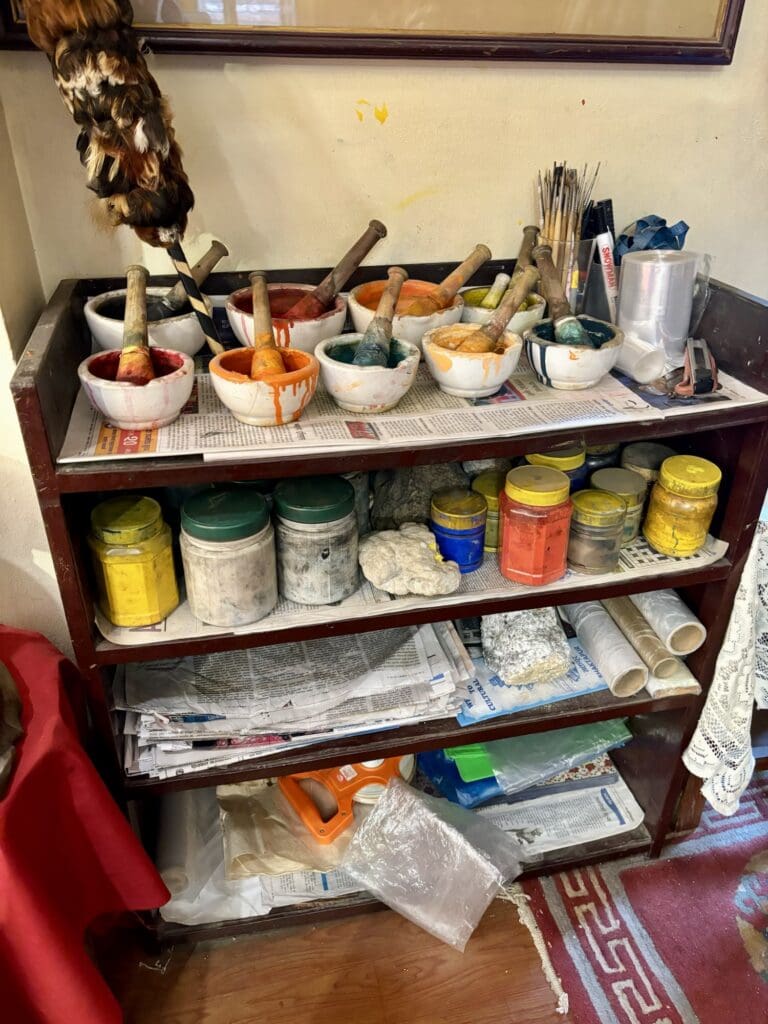
After briefly walking through Potters’ Square, our guide took us to sample local dessert – juju dhau, “King Curd,” frozen yogurt served in small clay pot. It had a vanilla taste to it, and it was delicious!


We had lunch at Dé Temple Cafe on a balcony overlooking Dattatraya Square. The soundtrack for our meal was a beautiful Indian devotional being played on repeat from a shop across the square. I was struck by how peaceful I felt while listening to it, so I asked our guide to take us over there after lunch (because I need all the calm in my life that I can get). I learned that the song was “Ong namo” by Snatam Kaur Khalsa (born in Colorado), and I was able to buy her CD, Grace. Ong Namo Guru Dev Namo means “I bow to the divine teacher within.”

For our final stop in the square, our guide took us to see the Peacock Window, the finest carved window in the Kathmandu Valley, located at the Woodcarving Museum set in former 15th-century Pujari Math (a Hindu priest house).


We closed out another full day with our fellow adventurer friend, Casey, at the hotel rooftop bar for food and drinks in the evening. It was fitting to run into her here, as we all met during our first international rafting trip with BioBio to the Futaleufu River in Chile in December 2021. She had just returned to KTM from the Karnali River, so we peppered her with questions on what to expect in the next week. It was also just fun to catch up and swap travel stories, as well as to hear about her move to Alaska.

Since we had a full day guided tour yesterday, we opted to stay local in/near Thamel on Thursday. We walked to the nearby Narayanhiti Palace – equal parts royal residence, time machine, and crime scene. It was the site of a royal massacre during a family gathering on June 1, 2001 when Crown Prince Dipendra shot dead nine of his relatives, including his parents the King and Queen, before killing himself. We found the experience of touring the buildings and grounds to be quite morbid because everything is so well preserved after the massacre and subsequent end of the monarchy in 2008. In fact, the bullet holes are still visible.

Before passing through the entrance gates, all bags, cameras, and phones must be left in the lockers at the entrance and visitors have to pass through multiple security checks while on the premises. As we toured the site, we passed through the extravagant staterooms piled high with gifts from visiting dignitaries, apartments for visiting dignitaries, and the surprisingly more down to earth living spaces of the royal family (including the children). We concluded our visit outside to see the royal aircraft and fleet of limousines. Simply put, it’s as if time stopped here, as everything was very dated from the end of the previous century.

After that bizarre experience, we needed some grounding in nature. So, we walked to the Garden of Dreams, a short walk from central Thamel. But, we had to cross a major traffic intersection on our walk (much larger than the one pictured here). Crossing eastern Kathmandu’s busy roads is a stressful experience with traffic police directing vehicles (there are minimal stoplights in the city) and motorbikes zipping about in every direction. Essentially, do as the locals do – cross cautiously, but with purpose.
We found the Garden to be a welcome respite from the chaos of KTM outside of the walls. It is an English-inspired garden built in 1920s featuring cream-colored statues, pavilions and pergolas, fountains, lily ponds, and lush plant beds. While there, we had lunch at the Austrian-inspired Kaiser Cafe inside the Garden and later enjoyed the large bamboo swing.

Having survived another solo day outside of the compound, we met up with Derik (previous trip lead at Futa) and Stan (from South Africa) at 5:30pm at our hotel for a pre-departure meeting. We met the other members of our group (10 guests total) and picked up our large dry bags to pack for the river. The bus was leaving at 3am to make the 17-hour drive to the river with all of the gear needed for our rafting expedition.
After group introductions and trip instructions over drinks, the other guests went to dinner together as a group, while Kurt and I went to New Orleans Cafe on a recommendation from Casey. And, I’m glad we did, as I enjoyed the best meal of the trip so far (Choila Kathmandu Beef) in a fun outdoor courtyard decorated with prayer flags and upbeat music playing. As a precaution for the next portion of the trip, we started taking our course of anti-malarial medications.


Friday was our final full day in Kathmandu, and one of the activities that I wanted to do here was to take a yoga class. So, I attended a hatha yoga class with Charak Yoga at our hotel at 9:30am. Only two other participants were there. Then, we indulged in another 90-minute deep-tissue massage, this time at Zen Spa (located across the street from our hotel; credit cards accepted) at 11:15am. Highly recommend!
Feeling blissed out, we went to lunch at one of Thamel’s old-school courtyard restaurants, Electric Pagoda, located behind our hotel (I had a delicious salad). We packed our dry bags for the trip in the afternoon before heading back to Electric Pagoda for a pre-trip group dinner. With an early departure time in the morning, we called it a night early. The real adventure is still ahead!








